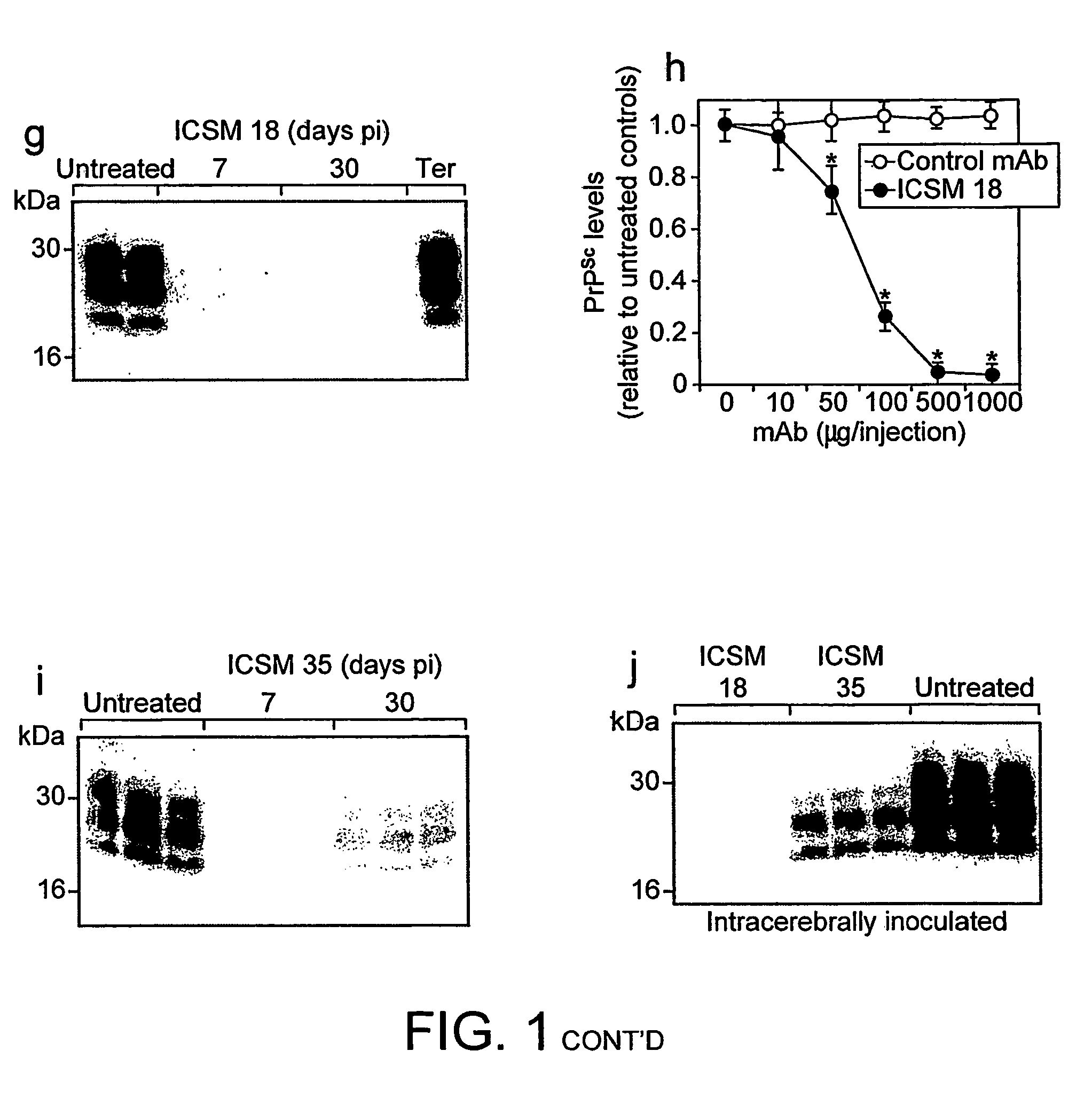Prion inhibition
a technology of prion and antigen, applied in the field of prion inhibition, can solve the problem that prior art techniques do not produce this advantageous effect, and achieve the effect of preventing prion replication
- Summary
- Abstract
- Description
- Claims
- Application Information
AI Technical Summary
Benefits of technology
Problems solved by technology
Method used
Image
Examples
example 1
Production of Agents for Use in Prion Inhibition
[0135]Recombinant human PrP91-231 folded into either alpha or beta conformations8,9 was used to produce monoclonal antibodies in Prnp0 / 0 mice10 that are intolerant of PrPc.
[0136]ICSM 35, an IgG2b mAb raised against beta-PrP, with high affinity for both murine PrPc and PrPSc (FIG. 1a) recognises a region between amino acid residues 91-110.
[0137]ICSM 18 (isotype IgG1), raised against alpha-PrP, recognises residues 146-159 of murine PrP and has a lower affinity for PrPSc (FIG. 1a).
[0138]Production of monoclonal antibodies. ICSM 35 and ICSM 18 monoclonal antibodies were produced. ICSM and BRIC mAbs were identically affinity-purified from culture supernatant, concentrated, and stored as sterile solutions without vehicle protein at 4° C. MAbs were used undiluted or diluted in PBS prior to use in vivo.
example 2
Use of Anti-PrP Antibodies in Prion Inhibition in Vivo
[0139]FVB / N mice were challenged intraperitoneally (ip) with RML scrapie brain homogenate derived from terminally scrapie-sick mice and treated with ICSM 35, ICSM 18 or isotype control antibodies BRIC 126 (IgG2b) and BRIC 222 (IgG1) by twice weekly ip injection (2 mg per injection) from 7 or 30 days post inoculation (pi).
ELISA of ICSM Antibodies in Mouse Serum
[0140]Serum levels of ICSM 35 and ICSM 18 treated mice (4 mice / group) were quantitated by ELISA 30 days after commencing twice weekly 2 mg intraperitoneal injections. Serum ICSM 35 and ICSM 18 levels 4 days after the last treatment were 460±50 and 398±38 μg / ml respectively (mean±SD). The difference was not significant (P<0.10, ANOVA).
[0141]Thus, ELISA analysis after 30 days of mAb treatment revealed no significant differences between ICSM 35 or ICSM 18 mAb levels in the serum.
[0142]Western blots of Proteinase K-treated, phosphotungstic acid-precipitated PrPSc from spleens of...
example 3
Treatment / Prevention of Prion Disease in Subjects
[0153]Evidence for accompanying clinical benefit is presented in this Example.
[0154]Treatment is effective if begun before the onset of clinical scrapie (Table 1).
[0155]Mice that were inoculated intraperitoneally with RML scrapie and treated with ICSM 35 or ICSM 18 (2 mg twice weekly) from 7 and 30 days pi continue to survive for much longer than untreated mice or mice treated with isotype control antibody (Table 1).
[0156]The mean survival for untreated ip inoculated mice was 197±5 days. All mice treated with ICSM 18 or ICSM 35 from 7 or 30 days post ip challenge have survived for more than 400 days pi at the time this manuscript was prepared (Table 1); an extension of the incubation period by at least 100% (p<0.001, ANOVA). No clinical signs of scrapie (as described in the Methods section) or weight loss (FIG. 4) have yet been observed in these mice.
Mouse Body Weights in ICSM Antibody Treated and Control Mice
[0157]Untreated intracere...
PUM
 Login to View More
Login to View More Abstract
Description
Claims
Application Information
 Login to View More
Login to View More - R&D
- Intellectual Property
- Life Sciences
- Materials
- Tech Scout
- Unparalleled Data Quality
- Higher Quality Content
- 60% Fewer Hallucinations
Browse by: Latest US Patents, China's latest patents, Technical Efficacy Thesaurus, Application Domain, Technology Topic, Popular Technical Reports.
© 2025 PatSnap. All rights reserved.Legal|Privacy policy|Modern Slavery Act Transparency Statement|Sitemap|About US| Contact US: help@patsnap.com



